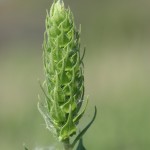Sulfaweed, Broadleaf Sumpweed, Annual Marsh Elder
Iva annua L.
Asteraceae (Sunflower Family)
Description
Sulfaweed is a native, warm-season annual in the Sunflower family. It is also called Broadleaf Sumpweed, Broadleaf Marshelder, Seacoast Sumpweed, and Pelocote. The plant can grow from 2 to 6 feet or 0.6 to 1.8 meters tall. It has enough hair to be rough to the touch. Its root system includes a short taproot and fibrous rootlets. The leaves are situated in pairs across from each other, or opposite, on the stem and have dentate or toothed margins. They are lanceolate, ovate, or broadly ovate in shape. Each leaf has three major veins visible on the lower or inner leaf. The upper leaf surface is green and sparsely covered with short hairs. The lower surface is light green to green and moderately covered with short hairs. Longer hairs can occur at the basal margins. Sulfaweed blooms in the summer and fall, typically from July to November. A key characteristic is the presence of many small, leaflike bracts around every flower in the flowering stem. Flowerheads can measure 2 to 8 inches or 5 to 20 cm long. The forage value of Sulfaweed is fair for wildlife and when the plant is young, fair for livestock. It also provides food and shelter to many insects, serving as a larval host for some moth and beetle species.Habitat
Sulfaweed is widely distributed across the eastern and central parts of the United States. This plant grows in moist soils in disturbed areas, roadsides, river bottom prairies, croplands, and coastal bermudagrass pastures. It is commonly found in the inland salt and brackish marshes along the Gulf Coast in region 02.Images
Plant Characteristics
Flower Color: Green, White, Yellow
Seed Type: Achene
Duration: Annual
Stem Texture: Hairy
Growth Habit: Forbs/Broadleaf
Leaf Shape
 : Simple with Pinnate or Parallel Venation
: Simple with Pinnate or Parallel Venation
Season: Warm
Distribution
 : 01 - Pineywoods, 02 - Gulf Prairies and Marshes, 03 - Post Oak Savannah, 04 - Blackland Prairies, 05 - Cross Timbers and Prairies, 06 - South Texas Plains, 07 - Edwards Plateau, 08 - Rolling Plains
: 01 - Pineywoods, 02 - Gulf Prairies and Marshes, 03 - Post Oak Savannah, 04 - Blackland Prairies, 05 - Cross Timbers and Prairies, 06 - South Texas Plains, 07 - Edwards Plateau, 08 - Rolling Plains
Distributions
Distribution refers to the ecological region in Texas that a plant has been found. You can also view a clickable map.
Book: Brush and Weeds of Texas Rangelands (B-6208)
Collection: Brush and Weeds







